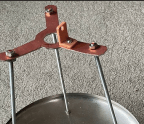Announcing: The 2021 CQ World Wide 160-Meter Contest
CW: 2200Z January 29 to 2200Z January 31
SSB: 2200Z February 26 to 2200Z February 28
DEADLINES FOR LOG SUBMISSIONS ARE 5 DAYS!
I. OBJECTIVE:
For amateurs around the world to contact other amateurs in as many U.S. states, Canadian provinces, and countries as possible utilizing the 160-meter band.
II. BAND USE:
1810-2000 kHz in ITU Region 1; 1800-2000 kHz in ITU Regions 2 and 3. All entrants are encouraged to spread out as much as possible, obeying frequency restrictions and power limits for their own country. Any violations of the ITU band use may result in disqualification.
III. CATEGORIES:
General Rules:
The use of one and only one remote receiver located within 100 kilometers of the main transmitter site is permitted, in addition to the receiver at the transmitter site. WebSDRs are OK, but must be located within the 100-kilometer limit. The rule is designed to accommodate new technology,
You’re reading a preview, subscribe to read more.
Start your free 30 days

